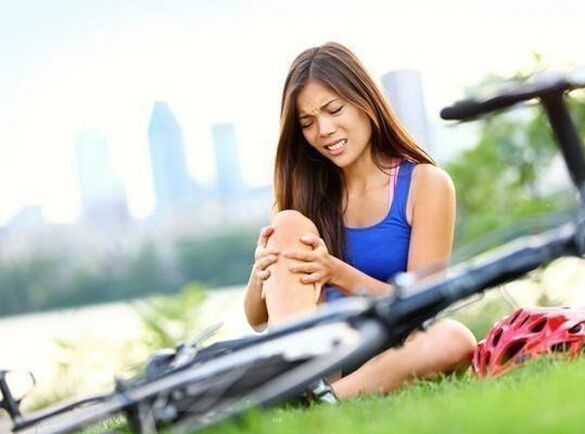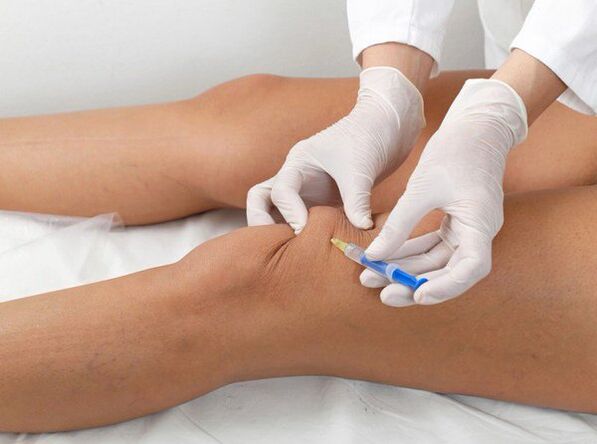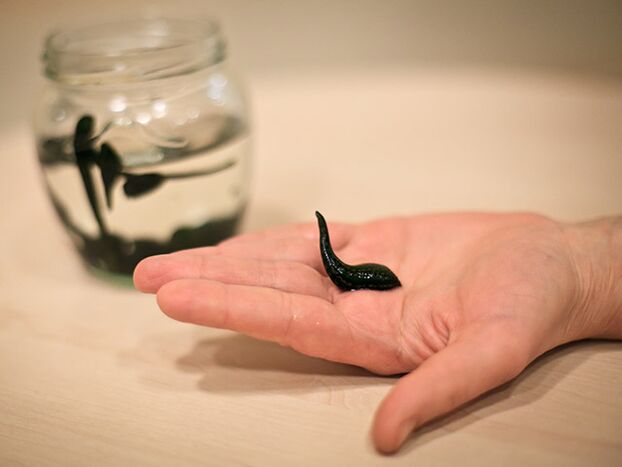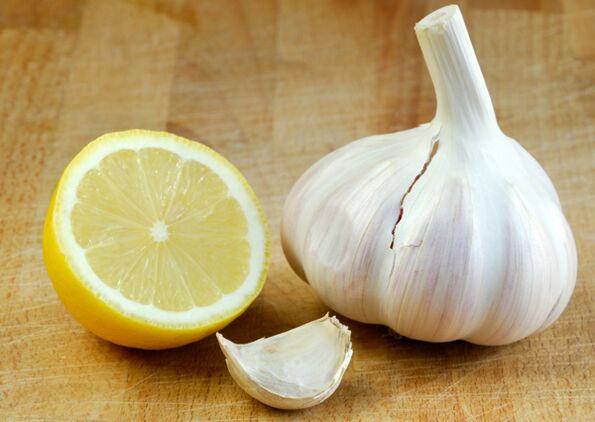The knee joint is made up of a mobile “tandem” of the tibia and femur.Their lateral movement is prevented by the patella, and easy sliding movement is provided by an elastic layer of durable cartilaginous tissue.
The thickness of the “healthy” cartilage lining the articular surfaces of the bones of the knee joint is 5-6 mm.

This is enough to soften the mechanical friction of the bones and absorb the “shock” load.A disease leading to the destruction of the natural shock-absorbing tissue and deformation of the joint - gonarthrosis, or osteoarthritis of the knee joint, has unpleasant symptoms and its treatment is often made difficult by the launch of a compensatory mechanism from bone structures.
What triggers the disease?
There is an opinion that gonarthrosis of the knee is a consequence of “salt deposition”.However, calcification, or deposition of calcium salts in the ligamentous apparatus of the knee, has no independent significance and is more of a consequence than a cause.
What is knee osteoarthritis and how to treat it?
In reality, the “starting point” should be considered a violation of blood supply to small bone vessels and its consequence – difficulties in the trophism of cartilaginous tissue and its depletion.A deformation of the hyaline cartilage follows.The latter exfoliates and becomes covered with multidirectional cracks.The synovial fluid becomes more viscous and loses its natural “moisturizing” properties of the cartilage tissue.
The complete disappearance of the drying “shock absorber” could be called the end of the pathological process.
However, underlying bones that have lost their cartilaginous “covering” compensate for this loss by growing along the periphery and becoming covered with “spikes” – bony growths.In this case, the knee joint is deformed and the legs take the shape of an X or O, therefore this pathology is also called deforming osteoarthritis of the knee joint (hereinafter referred to as DOA).
What are the causes of knee osteoarthritis?
- The aging of the body and the “wear and tear” of the joints that accompanies it;
- Excess body weight;
- Extreme loads on the knee joint (in athletes);
- Knee injury, fracture of one of his bones;
- Removal of the meniscus;
- Arthritis, untreated rheumatism;
- Abnormal location of the bony components of the joint;
- “Failure” of the endocrine system and hormonal disharmony, metabolic imbalance.
Osteoarthritis is often confused with various arthritis.
However, the difference between arthritis and arthrosis of the knee joint is that the first is often the result of the invasion of the body by various pathogens, which “leads” to inflammatory diseases of the whole body.
Sometimes the signs of arthritis – inflammation and swelling of the joint, swelling, pain that gets worse at night – are the result of the immune system “deploying” an active defense against the body’s own cells.
Osteoarthritis, being an exclusively local disease, often becomes a logical continuation of arthritis or a consequence of progressive “wear and tear” of the joint.
Primary and secondary knee osteoarthritis
In orthopedics and traumatology, types of osteoarthritis of the knee joint are usually distinguished depending on the reasons that gave rise to degenerative changes in the articular cartilage.
- Age-related or primary gonarthrosisThe knee joint often disrupts the course of relatively painless old age due to physical "wear and tear" of the cartilage tissue.A little more often than men, women who have crossed the 40-year mark are faced with this form of the disease.The early development of primary gonarthrosis threatens athletes and those who have extra pounds;
- Secondary gonarthrosis– logical continuation of a previous injury or consequence of untimely treatment of inflammatory diseases, develops at any age.

Where is the disease hiding?
Developing gradually, gonarthrosis is localized in the internal part of the knee joint.However, the disease can “hide” between the kneecap and the surface of the femur.
- Left-sided knee osteoarthritis often affects athletes and overweight people;
- People whose professional or sports activities involve excessive dynamic or static loads on the right leg are more susceptible to degenerative changes in the cartilaginous layer of the right knee joint;
- Bilateral knee osteoarthritis is often linked to age.Whatever the reasons, uncontrolled destruction of both knee joints in most cases leads to disability.
Oh, it hurts!
Signs of gonarthrosis of the knee joint are quite vague at the beginning of the disease, and few people will rush to consult a rheumatologist or arthrologist if they feel knee pain after a long hike.
After all, a short rest and relaxation relieves the unpleasant symptoms of a slightly "creaky" knee, giving a dubious feeling of physical well-being.
In fact, “vague” symptoms of the early stages of degenerative diseases of the musculoskeletal system make their detection and timely treatment extremely difficult.Deforming gonarthrosis is no exception.
- Stage 1 knee osteoarthritis, which manifests itself only as slight discomfort caused by fatigue of the limb, is extremely difficult to recognize on one's own.A timely impulse to consult a doctor is often given by a dull pain in the knee and the “crunching” of the rough cartilages clinging to each other;
- Gonarthrosis of the 2nd degree opens the way to deformation of the knee joint and interferes with its movements in the morning, causing the need to “diverge”.Severe, prolonged pain occurs after standing or sitting for a long time.Moderately limited knee mobility is accompanied by a cracking sound;
- The maximum signs of osteoarthritis of the knee joint appear in the third stage of the disease.A swollen knee, with an increased local temperature, often hurts when resting.
The movement of the joint is blocked by sharp pain caused by “joint mice” – fragments of broken bone growths.
A deformed joint loses its stability and is difficult to move.Advanced disease at this stage requires prosthetics.
Can knee osteoarthritis be cured?
The famous statement “Rest is not an end in itself, but a means to an end” speaks directly to those who are faced with the first manifestations of the disease.Rest ensures maximum unloading of the knee joint during an exacerbation.For the same purpose, the use of individual orthopedic insoles is recommended.

The use of individual orthopedic insoles will ensure maximum relief of the knee joint.
A kind of insurance against the disease, or rather against its exacerbation, will be special orthotics that support the stability of the “loose” knee joint in athletes.
A cane will help older people “unload” their joints while walking.But the listed measures are more likely to prevent osteoarthritis of the knee joints.If such “vaccination” did not help and the worsening of gonarthrosis is manifested by inflammation and pain, you should hurry to consult an orthopedist or arthrologist.
How to treat knee osteoarthritis?
- Step 1.Reduce inflammation and accompanying pain.Non-steroidal anti-inflammatory drugs used orally, intramuscularly or intravenously will better resolve the “acute” problem.NSAIDs “sealed” in rectal suppositories will have a prolonged effect.
The use of corticosteroids is also justified - they are “delivered” directly to the diseased joint.
Local use of ointments or gels containing an active anti-inflammatory component will help enhance the anti-inflammatory effect of NSAIDs used internally.These help to quickly relieve swelling.

Drugs that reduce vascular muscle tone are often prescribed in combination with NSAIDs.This improves periarticular blood flow.
What to do with osteoarthritis of the knee joint, for example, in patients suffering from gastrointestinal diseases for whom taking NSAIDs and painkillers is dangerous?
Oxygen therapy would be a good alternative.
- Step 2.“Feed” dried cartilage with substances that stimulate collagen synthesis.Chondroprotectors intended for this purpose act slowly, but their long-term use promotes the synthesis of natural components of the cartilage matrix.The greatest effect is achieved by intra-articular administration of drugs.
- Step 3.We smooth the “roughness” of the cartilage and reduce the friction of the cartilage by introducing hyaluronic acid.
- Step 4.We improve the blood supply and trophism of the joint through physiotherapy.For this purpose, it is recommended to combine business with pleasure and to undergo treatment in a sanatorium.
- Step 5.We turn to non-traditional treatment methods: acupuncture and hirudotherapy, apitherapy.An innovation in the treatment of AOD of the knee joint is the intra-articular administration of Orthokine, a serum obtained from the patient's blood proteins.


What are the right exercises to do?
Physiotherapy will help slow down the progressive destruction of joint elements.Its main objectives:
- improve blood supply to the joint and activate the trophism of all its components;
- increased knee mobility;
- increase the tone of all muscles of the human body.
It is recommended to carry out physiotherapy sessions, at least initially, under the supervision of a physiotherapy instructor.An experienced trainer will select exercises that correspond to the level of joint mobility, excluding large amplitude exercises and exercises with excessive axial load - all this can damage the soft tissues of the joint and worsen the patient's condition.
Recipes from the green pharmacy: there are options!
Provides gonarthrosis and treatment with traditional methods:
- Option 1.Grind 120 g of garlic, 250 g of celery root and 3 lemons in a meat grinder.Place the mixture in a 3 liter pot and fill it to the top with boiling water.Having kept the composition overnight in a warm place, tightly wrapping the jar, start taking it in the morning, consuming 70 grams of the drug every morning.Gradually increase consumption up to 3 times;
- Option 2.Treat the painful joint with a mixture of 1 tbsp.L.honey and 3 tbsp.L.apple cider vinegar.Place a leaf of fresh cabbage on top (beat it lightly with a knife) or burdock (light side towards the joint).Wrap your leg in cellophane film and a soft scarf.Do it at night, up to 30 procedures.

Unavoidable decision
Often severe pain and joint dysfunction threatens disability.
Then middle-aged patients, as well as young people who have been diagnosed with osteoarthritis of the knee joint, require surgical intervention.
The most common procedure is stenting.The duration of such an operation does not exceed one hour, and its effect is painless operation of the “restored” limb for at least 20 years.Over time, the “loose” denture will need to be replaced.






















